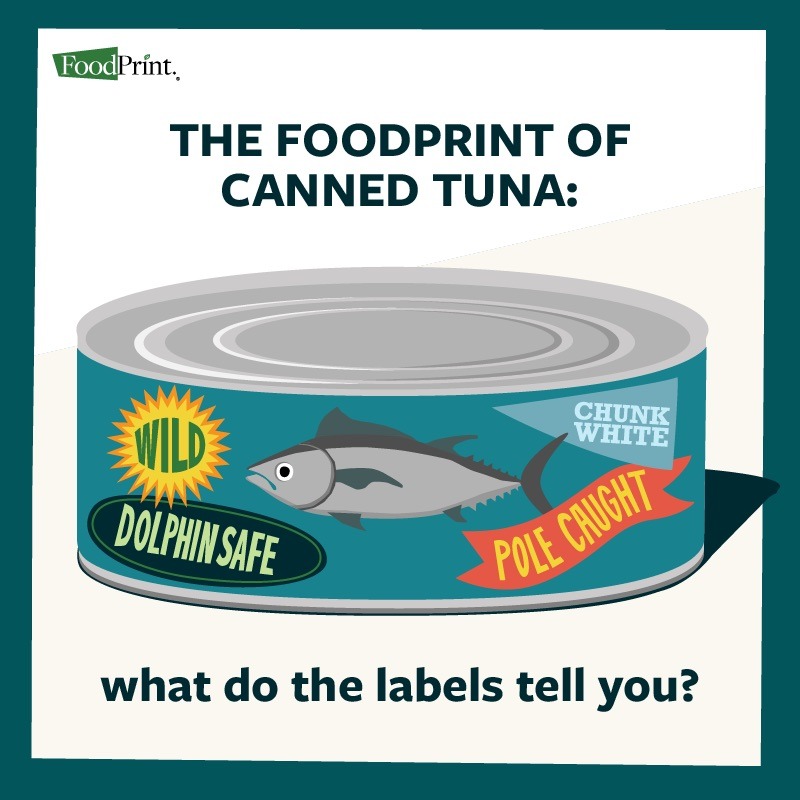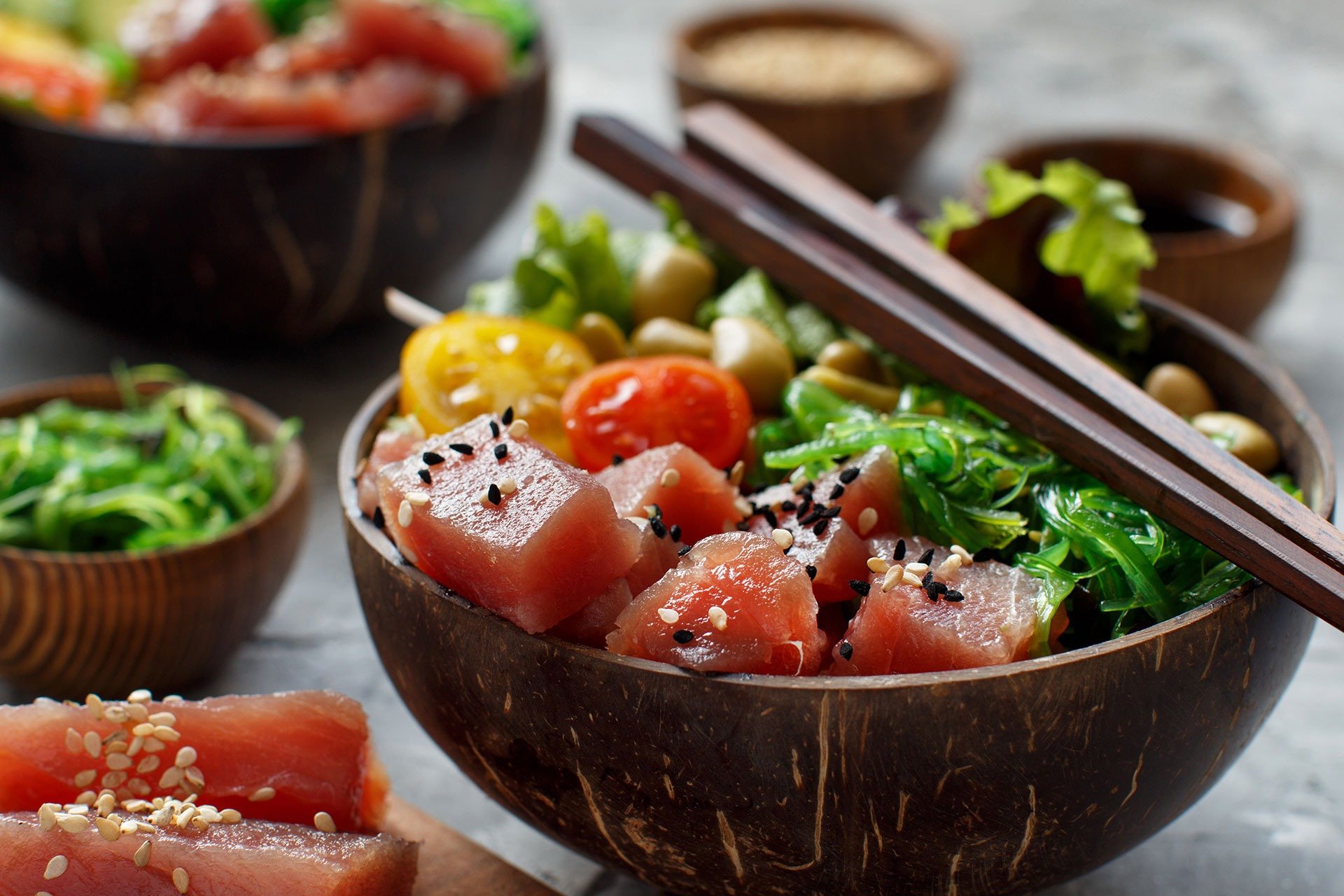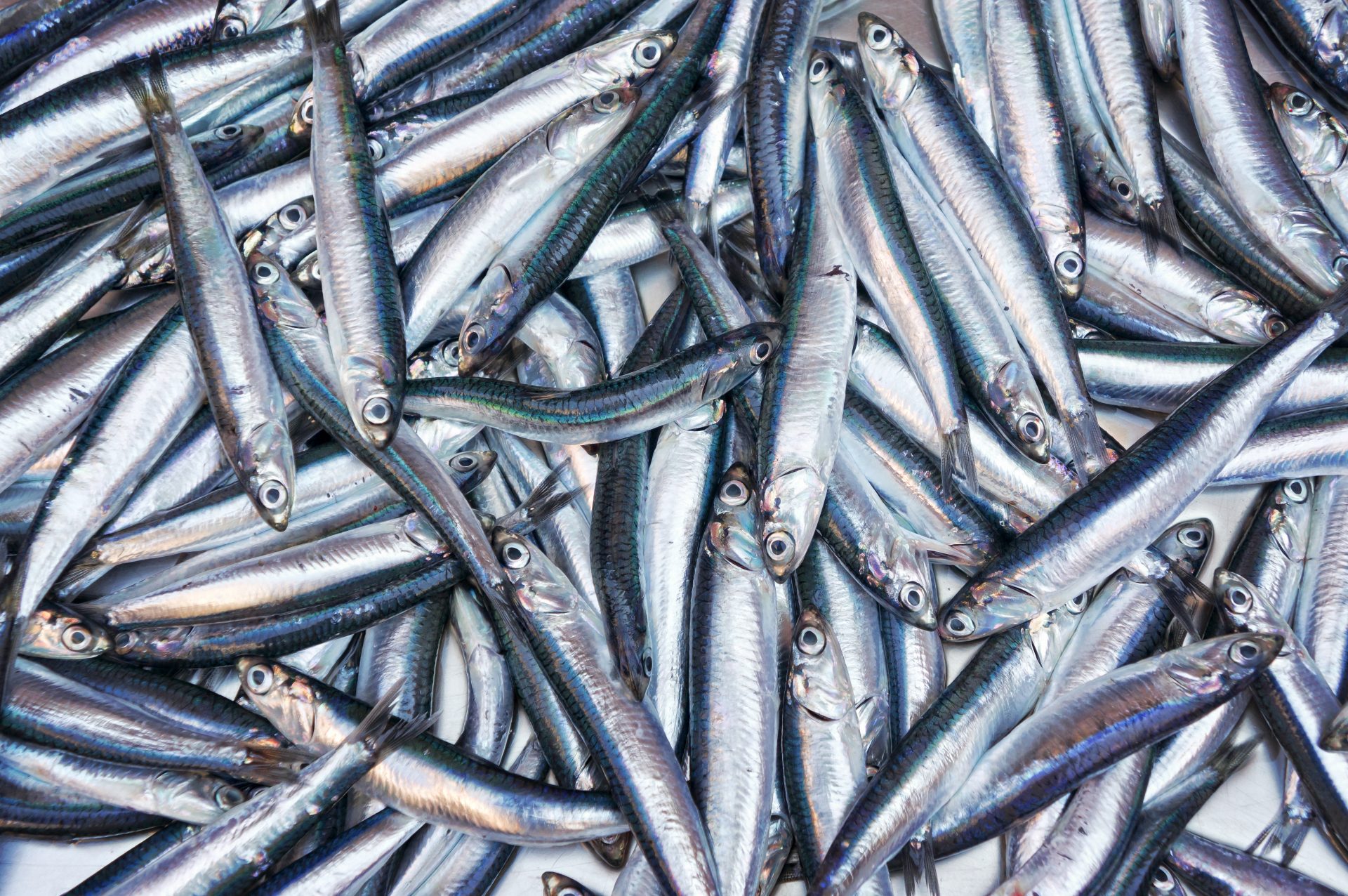What Do Tuna Can Labels Tell You About Sustainability?
Pluck a can of tuna off a supermarket shelf and you’re engaging in a seemingly mundane act akin, you might think, to choosing your sock color. But that tuna can represents more than a quick, nutritious, affordable meal. It’s also a symbol of the complexity of our food system — and our expectations of filling our bellies while inflicting no harm on the environment, interconnected species, or the people who farm and fish on our behalf.
The FoodPrint of Tuna
Sustainable is a word with squishy meanings. In the context of tuna, it can indicate that no more members of the Thunnini tribe were taken out of the oceans than can regenerate — assuring healthy stocks that will feed humans…for now.
But when we talk about the foodprint of tuna, we might also ask: Are there enough tuna left in the ocean to support other animals that rely on it for their dinner? Are there enough to balance populations of the fish tuna prey on? Are stocks of fish used as tuna bait healthy, too? Was there negligible by-catch of turtles, sharks, dolphins, and birds? How much fuel did a fishing boat use? Do workers receive fair wages for their own sustainable future? And if you consider your physical health a matter of sustainability, then mercury levels in tuna are also something to think about.
- Bycatch
- According to NOAA Fisheries: “Fishermen sometimes catch and discard animals they do not want, cannot sell, or are not allowed to keep. This is collectively known as ‘bycatch.’ Bycatch can be fish, but also includes other animals such as dolphins, whales, sea turtles, and seabirds that become hooked or entangled in fishing gear,” often suffering injuries and/or mortalities.
Given all of those considerations, can we call canned tuna sustainable? The answer is complicated and depends on what kind of tuna and how it was caught. And for every positive, there’s a tradeoff; and as Susan Jackson, president of International Seafood Sustainability Foundation (ISSF) elaborates, “Mitigation measures that are good for one thing can be bad for another.” But there is good news and, thanks to governments, NGOs, foundations, and researchers working in tandem to improve tuna fisheries the world over, the news has the potential to get better.
Tuna Labels and Certifications
Eco-logos can help erase some confusion about what’s in your tuna can, if you know what they mean. The Marine Stewardship Council (MSC) offers the most rigorous 3rd party certification of fisheries available. Its logo is generally considered the gold standard of sustainability, signifying that fisheries have good stock numbers, low ecosystem impacts, and effective management along the supply chain. Fair Trade USA 3rd-party certifies that the fishermen and other humans behind a can of tuna “got a fair deal for their hard work,” according to their website.

Other logos are more targeted, referring to the type of gear used to catch the tuna in your can, such as pole and line, FAD-free, or circle hook—generally, the gear is mentioned because its use is positive. Still others tout what wasn’t harmed to bring you tuna, i.e., dolphin-safe and turtle-safe logos. Logos claiming tuna is “sustainably caught” or “responsibly caught” without indicating how that claim is backed up may not mean much. Finally, almost all tuna that ends up in a can starts out “wild,” making this claim superfluous.
Who’s Looking Out for Tuna?
Tuna occupy waters in open oceans and migrate great distances between them, crossing and re-crossing international boundaries, in and out of the Exclusive Economic Zones that exist within 200 nautical miles of a particular country’s coastline and allow a country to call a fish their own.
Because of this interconnectedness, the management of tuna fisheries is overseen by five Regional Fishing Management Organizations, or RFMOs, each made up of representatives from the countries with a stake in the particular fish caught in those particular waters. These RFMOs set catch limits and determine if a fishery needs to be closed to fishing in order to recover its stocks. From there, says Jackson, it’s up to individual countries to establish laws and policies that control what goes on.
Additionally, various organizations and consortiums work with governments, tuna vessel owners, tuna brand owners, retailers, and consumers to encourage them to make meaningful changes in management practices, based on scientific data collected from organizations like ISSF and Monterey Bay Aquarium’s Seafood Watch program.
The Basics of Tuna Species
Seven species of tuna are commercially fished. Keep in mind that the larger the tuna, the higher its mercury levels.
[For more info on the very real and serious health implications of the mercury in fish, check out this FoodPrint explainer.]
Bluefin Tuna
Three of the seven species are bluefins, 10-foot-long prizes of sushi and sashimi chefs that have been fished to near collapse and are now subject to recovery programs. You likely won’t find these fish in cans; they’re too valuable.
Bigeye and Yellowfin
Bigeye and yellowfin are the next-largest tunas, growing to around 7 feet long. Both species turn up as solid light or chunk light in a can.
Bigeye stocks are considered healthy everywhere but in the Atlantic. Yellowfin stocks are healthiest in the Pacific, but overall, the species has shown it’s responsive to good management “in all locations around the world,” says Bill Fox, vice president of fisheries for the World Wildlife Fund (WWF). Unhappily, mercury levels in this big fish are high; a can of yellowfin may contain around .32 parts per million.
Albacore
The same is true for mercury in albacore, i.e. solid white or chunk white. In all oceans where it’s caught, albacore “stocks are doing fairly well, and that’s awesome,” says Megan Bailey, a fisheries economist at Dalhousie University in Halifax, Canada, who studies tuna traceability and governance.
Skipjack
Last, there’s skipjack, the smallest of the commercial tunas, which you know as chunk light. They’re extremely resilient, “showing very little impact from fishing, even though they represent the majority of the canned tuna market,” says Fox. They’re also low in mercury—containing about .12 parts per million.
From here, all things canned tuna get significantly more complicated.
| Type of Canned Tuna | Tuna Species |
|---|---|
| Tuna Species Chunk Light |
Bigeye and Yellowfin Skipjack |
| Tuna Species Chunk White | Albacore |
| Tuna Species Solid White |
Bigeye and Yellowfin Albacore |
The Gear Used to Catch Tuna
All seven types of tuna are caught in various ways. Which species, caught where, and how, and by whom, and using how much fuel, has seemingly infinite variables of good and bad and tradeoffs — weighed, in dizzying depth, on Seafood Watch’s “Tuna Recommendations” page. A simpler rule of thumb comes from Katie Matthews, chief scientist at Oceana, an international ocean advocacy organization: “If a tuna label doesn’t say how it was caught, they probably don’t want you to know.” The converse is also true.
Here’s a primer on the gear:
Gillnets
Gillnets are simple structures favored by small-scale fishermen in which net walls several kilometers long and up to 90 feet high are suspended mid-ocean in order to catch basically any fish swimming through.
All gear has collateral problems, says Fox. “But the only gear people can come together on and say, it’s not good, is gillnet fishing. The collateral effects on the ecosystem” — high shark by-catch and turtle mortalities — are huge. You won’t find a tuna can touting the fact that its contents were caught with gillnets.
Longlines
Longlines are, quite literally, miles-long fishing lines from which leaders and many hooks are hung. The problem with them, explains Matthews “is that a quarter of what you pull in can be by-catch like sharks, sea turtles, and sea birds and…there’s high mortality.” Greenpeace refers to longlines as “indiscriminate” and “destructive.” The industry has made improvements including nylon leads, “because the ‘bad guys’ use metal leads to [purposefully] catch sharks to cut their fins to sell and sharks can bite through nylon,” Matthews says. They have also added circle-shaped hooks that reduce sea turtle by-catch. You might find circle hooks noted on a tuna can. You might also find a can marked “no longlines.”
Purse Seine Nets
A boat circles a school of, probably, skipjack with a big net and cinches, or “purses” it closed. This method has given some Pacific Island countries a means to develop their economies, Bailey says, which makes it a plus for those looking to support the labor-focused side of canned tuna. It has the lowest fuel usage of the tuna fishing methods, although there is some incidence of by-catch. The “dolphin safe” logo that you might see on a purse-seined tuna can is governed by a US labeling law and means that no “dolphins were chased, encircled, or killed,” reports National Geographic. It doesn’t mean your tuna is turtle-, bird-, ray-, or shark-safe, though.
Ask what’s important to you—an economic system? Fish stocks? Come up with a brand or two that fit your values. Then, stick with them.
By-catch can increase significantly—as high as 9 percent in some regions—when purse seining is done from floating platforms called Fish Aggregating Devises (FADs)—considered by Greenpeace a gear to avoid. When you see “FAD-free” or “free school caught” on your can of tuna, it means its contents were purse-seined without this controversial gear.
Another problem is that purse seiners might be catching tuna both with and without FADs, depending on the day or even the hour. “It is certainly a complication that a [tuna] company that has one product line that’s sustainable also has 98 product lines that are not, and uses the same boats and crew for each, on the same trip,” says Bailey. MSC is working to increase transparency around this issue.
Pole and Line
By-catch is low with this gear, although only about 10 percent of canned tuna is caught with pole and line. One hook is cast on a line to catch one fish; relatively sustainable skipjack and yellowfin are its primary targets. The International Pole and Line Foundation works with small fisheries to ensure they’re socially and environmentally responsible. The gear is generally considered a sustainable option, and you’ll find cans labeled “pole and line caught,” or just “pole caught.”
However, it’s the least efficient method when it comes to fuel use. It also requires the use of bait. Small fish like sardines and anchovies are tossed into the water to “chum up” tuna, and that bait may or may not be sustainable. “The countries where we take the bait from don’t have management programs, so we don’t know how much is caught,” Fox says. Meaning the potential impacts on other animals are also unknown.
Trolling
This method accounts for 2 percent of the global tuna catch, but it has big pluses. Trolling, like pole and line, is a one hook/one fish type of operation that involves dangling a few individual lines off the back of a boat. However, it uses rubber lures rather than live bait. It targets young albacore, which tend not to school tightly together, and that means, says Jeremy Brown, a California-based troll fisherman, “It’s hard to put a hole in the population. Inefficiency is our strongest suit.”
Fuel use is high but by-catch is low. Tuna that’s been troll caught will come in a can proclaiming this.
Making the Tuna Industry More Sustainable
What would it take to get the tuna industry to the point where a consumer can confidently walk into a supermarket, pluck a can from the shelves without having to scour its label, and know that it was caught sustainably, in a multitude of ways?
Bill Fox thinks improving the work of certifiers who apply 3rd-party standards is critical, to ensure better transparency and healthier fisheries.
Oceana’s Matthews is encouraged by a current push for “better standards of catching, and trying to put mitigation measures in place so sensitive, protected species are not caught.” Better monitoring, she says, will help make sure that “what’s landed is properly counted and accounted for.”
Better technology has a role to play in that piece of the improvements puzzle, according to Jackson, as do better scientific knowledge around fish and fisheries and perhaps, most importantly, “political will to implement changes.” The single best thing a consumer can do? “Make a retailer know they care,” Jackson says.
Until the day that your tuna can is unquestionably sustainable on overlapping levels, Bailey suggests making a tough choice: “Ask what’s important to you—an economic system? Fish stocks? Come up with a brand or two that fit your values. Then, stick with them.”
Get the latest food news, from FoodPrint.
More Reading
Salmon hatcheries: Unsuccessful conservation, insufficient regulation, and poor animal welfare
September 16, 2025
Why farmed seafood deserves an ethical debate
September 8, 2025
Think you’re eating local seafood? Beware of 'local-washing'
May 21, 2025
When bycatch is on the menu
December 12, 2024
The quest for more sustainable caviar
July 3, 2024
Celebrating the Black history of oysters with chef Jasmine Norton
June 21, 2024
Oyster farming is the good kind aquaculture
April 2, 2024
A new report sheds light on the problems behind our imported shrimp
March 27, 2024
The collapse of fishing giant Blue Harvest exposes the weakness of catch share policies
November 20, 2023
Can We Really Eliminate Invasive Species by Eating Them?
July 19, 2023


